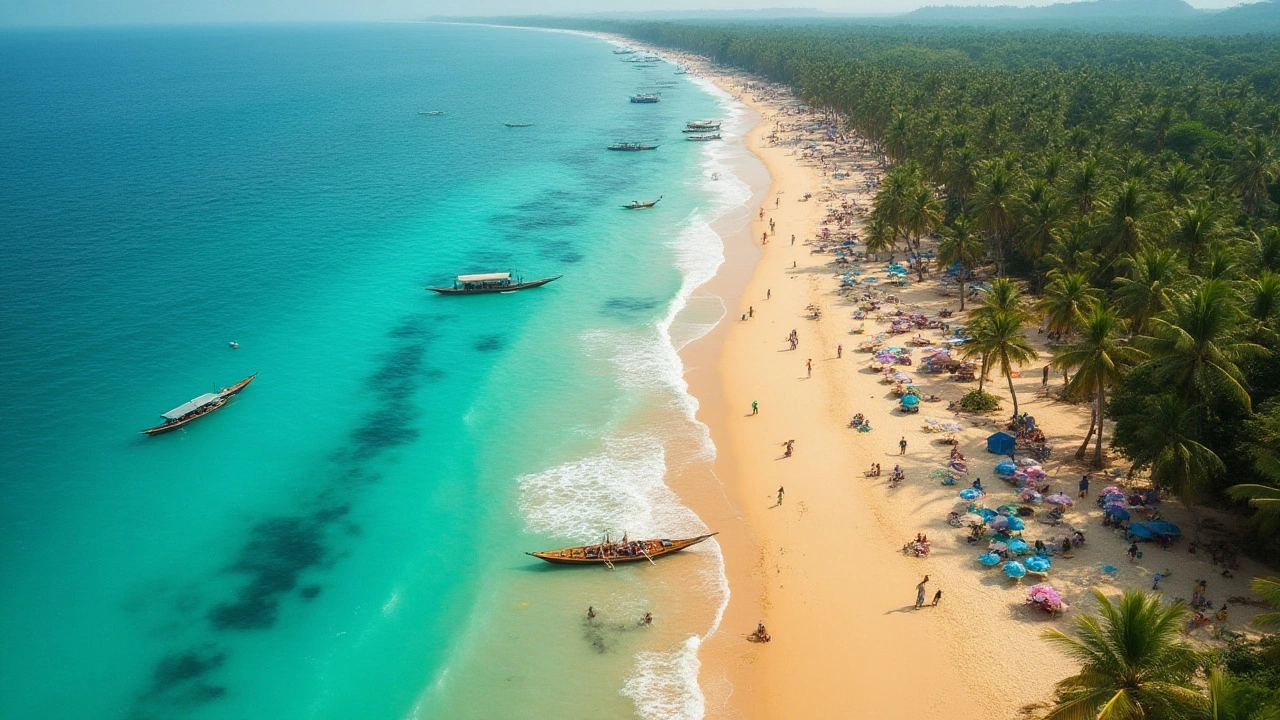Best Indian Beaches Like the Maldives: A Guide to Tropical Paradises in India
 Jul, 8 2025
Jul, 8 2025
If you’ve ever scrolled through those mind-blowing pictures of the Maldives—the kind where the water looks like turquoise glass and the sand could pass for powdered sugar—it’s hard not to catch yourself daydreaming. But, does India really have beaches that can put up a fair fight against the Maldives? Or is this just wishful travel talk? The truth is, you don’t have to drop a bomb on flights or wait for that perfect visa. India quietly boasts a handful of beaches with all the right ingredients: white sands, crystal-clear water, and even those jaw-dropping sunsets. It might sound wild, but some corners of India honestly look like they’ve been cut right from those luxury travel brochures.
Why People Compare Indian Beaches to the Maldives
The Maldives, hands down, has set the gold standard for dreamy beaches. We’re talking about over a thousand islands, floating in the Indian Ocean, famous for their overwater bungalows and endless blue. But here’s a fun fact—many parts of India sit right along the same ocean. The east coast meets the Bay of Bengal, the west touches the Arabian Sea, and way out in the ocean are the Andaman and Nicobar Islands, plus the Lakshadweep group. Geography’s on India’s side here.
So, why do these Indian beaches remind people of the Maldives? First, water clarity. The Maldives is all about those unreal shades—blues, greens, and every color in between. And we’re not just talking one spot—all around the archipelago, the water stays that clear. Some Indian beaches, especially in the Andaman and Nicobar Islands or Lakshadweep, have this same effect, with reefs nearly as rich and inviting.
Then there’s the sand. Maldivian beaches earn their sparkle from crushed coral sand, and guess what? Many of India’s island beaches have the same kind of powdery shorelines. So visually, you get a real déjà vu. Add in palm trees, secluded settings, and vibrant marine life—yeah, it’s starting to feel a lot like the Maldives, but with tandoori on the menu.
But there’s more. A little-known statistic published in "Condé Nast Traveller" shows more than 60% of international tourists visiting the Andaman Islands cite “Maldives-like scenery” as their main draw. Even the world-famous travel blogger Mark Wiens wrote,
“Havelock Island’s Radhanagar Beach gave me flashbacks of Maldives – the peace, the color of the sea, the forest line beyond – I’d never expected to see this in India.”What does this mean? It means the comparison isn’t just some hyped-up marketing gimmick. Travelers feel it for real.
Tropical Havens in India: The Closest You’ll Get to the Maldives
Ready for the highlight reel? If you want to find the real Maldives vibes in India, there are a few beaches that straight-up steal the show. Number one on almost anyone’s list is Radhanagar Beach, tucked away on Havelock Island in the Andamans. It's not just me hyping it up. Time magazine has called Radhanagar one of Asia’s best beaches. When I showed pictures of it to my wife, Maya, she genuinely thought I’d swiped a Maldives photo from Instagram.
Why is Radhanagar Beach so special? The curve of white sand cradles a sea that goes from turquoise at the shore to a deep blue just a little further out. The sand feels impossibly soft between your toes, and the water is so clear you can watch tiny fish darting around as you wade. But that’s just the intro act.
Havelock isn’t the only stunner. There’s Elephant Beach, famous for its lively coral reefs, perfect for snorkeling and even glass-bottom boating if you’re not keen to swim. Neil Island, just next door, packs a punch with Bharatpur Beach—think water so still and clear it looks like someone hit “pause.” On some days, the beach is almost empty except for a few fellow wanderers, which is a serious bonus if you’re trying to avoid crowds.
Don’t skip over Lakshadweep either, especially Agatti Island and Bangaram. The lagoons here are out-of-this-world blue, and you’d be hard-pressed to find more peaceful sands. Resorts are few and far between (don’t expect the Maldives’ overwater bungalows everywhere, but you’ll still get that exclusive island energy). Fun fact: Lakshadweep’s islands ban alcohol outside private resorts, so plan on sipping on coconut water and fresh lime instead.
Here’s a quick look at how these Indian beaches stack up next to the Maldives, based on common travel review sites and visitor feedback:
| Beach | Water Clarity | Sand Quality | Crowd Factor | Snorkeling |
|---|---|---|---|---|
| Radhanagar Beach (Havelock) | Excellent | Powdery white | Low to medium | Great |
| Bharatpur Beach (Neil Island) | Crystal clear | White, soft | Low | Good |
| Agatti (Lakshadweep) | Outstanding | White coral sand | Minimal | Excellent |
| Bangaram (Lakshadweep) | Exceptional | Flour-soft | Almost none | Excellent |
| Maldives (General) | Legendary | Coral, white | Low-medium (resorts) | Best in class |
While it’s not an exact copy, the vibe and feel are about as close as you’ll get in India. The best part? Getting there doesn’t cost a fortune, especially for Indian citizens. Foreigners have a few more hoops to jump through for Lakshadweep, but the guidance is simple: apply early for your permit, double-check flight connections, and pack light (many flights have tight luggage limits for island hops).

How To Make The Most Of Your Indian Beach Experience
So, you’ve decided to go for those Maldives-like beaches in India. Now, how do you get the most out of the trip? First up, timing is key. The ideal stretch is November to April, when the skies stay clear and the seas calm down. Monsoons in these regions can be rough—you don’t want your beach plans turned into rain-checks.
Book your stay early if you want the best deals or the most in-demand resorts, especially during the holidays. In places like Havelock or Agatti, the boutique hotels fill fast. Also, you might not find the international-chain resorts you’d expect in the Maldives, but the small-scale luxury stays are genuinely charming and much less commercial.
Bring cash. Many islands have patchy internet and credit card connectivity. The last thing you want is to be stuck trying to pay for lunch with a smile because the Wi-Fi’s down. Speaking of food, try the local seafood curry—just thinking about the kingfish thali Maya and I tried on Neil Island is enough to make me want to jump on a plane again.
For activities, snorkeling and scuba diving are the main ticket. You don’t need to be an expert. Most of the local guides are patient, helpful, and passionate about showing off their reefs. If you’re not into water sports, these islands are amazing for just wandering around and soaking up the quiet, watching birds, or taking boat rides at sunset. Don’t try to fill your schedule with too many islands—there’s something magical about slowing down and letting the sea set your pace.
Here’s a quick tip on eco-friendliness: these islands are sensitive, both environmentally and culturally. Carry your own bottles, leave no plastic behind, and go easy on the sunscreen and insect repellent when swimming—many products harm the coral. And yes, permits are required for foreigners headed to Lakshadweep, so double-check the regulations before you pack.
- Book flights and hotels 2-3 months ahead, especially during winter.
- Carry Indian Rupees for local restaurants and taxis.
- Rent a scooter or bicycle, not a car—the islands are small.
- Always snorkel with a licensed guide.
- Respect no-entry signs on tribal reserve areas in the Andamans.
Sometimes the best part is just floating on your back, staring at that endless blue, and realizing the Maldives level of peace is only a swim away.
Is It Really Worth Choosing Indian Beaches Over the Maldives?
That big million-dollar question—should you swap out your Maldives dreams for an Indian beach getaway? If you want that postcard-perfect sand and sea, without blowing your budget, the answer’s a loud yes. You might not get overwater villas everywhere or ultra-luxury spa menus on tap, but what you get is a slice of peaceful paradise where you can chill—sometimes with zero crowds.
Here’s the honest scoop from the global travel data site Statista: an average trip for two to the Maldives costs upwards of $4,000 USD for a week. Compare that with the Andaman Islands or Lakshadweep, where week-long packages for two can drop to half—or even a third—of that in shoulder season. The beaches aren’t as overly manicured, and your neighbors are more likely to be friendly local families than influencers filming reels, but that’s exactly the charm.
The best part? Indian island culture adds something you won’t find in the Maldives. Street markets, spicy chaats, and the comfort of a hot cup of chai by the sea—it has a vibe all its own. When Maya and I first saw Radhanagar Beach light up gold at sunset, we just sat quietly in the sand, thinking, “This could be anywhere in the world, but right now, it’s ours.”
Plus, India’s richness goes way past the beaches. On the same trip, someone might tip you off about an amazing hill trek, a secret waterfall, or a centuries-old fort hiding in the jungle. It feels less polished and more like an adventure you create along the way.
So if you’re after that maldives magic without the pricey overhead, India’s islands are calling. Don’t just look for the copy—enjoy what’s original, soak up the experience, and come home with a story that’s totally your own.